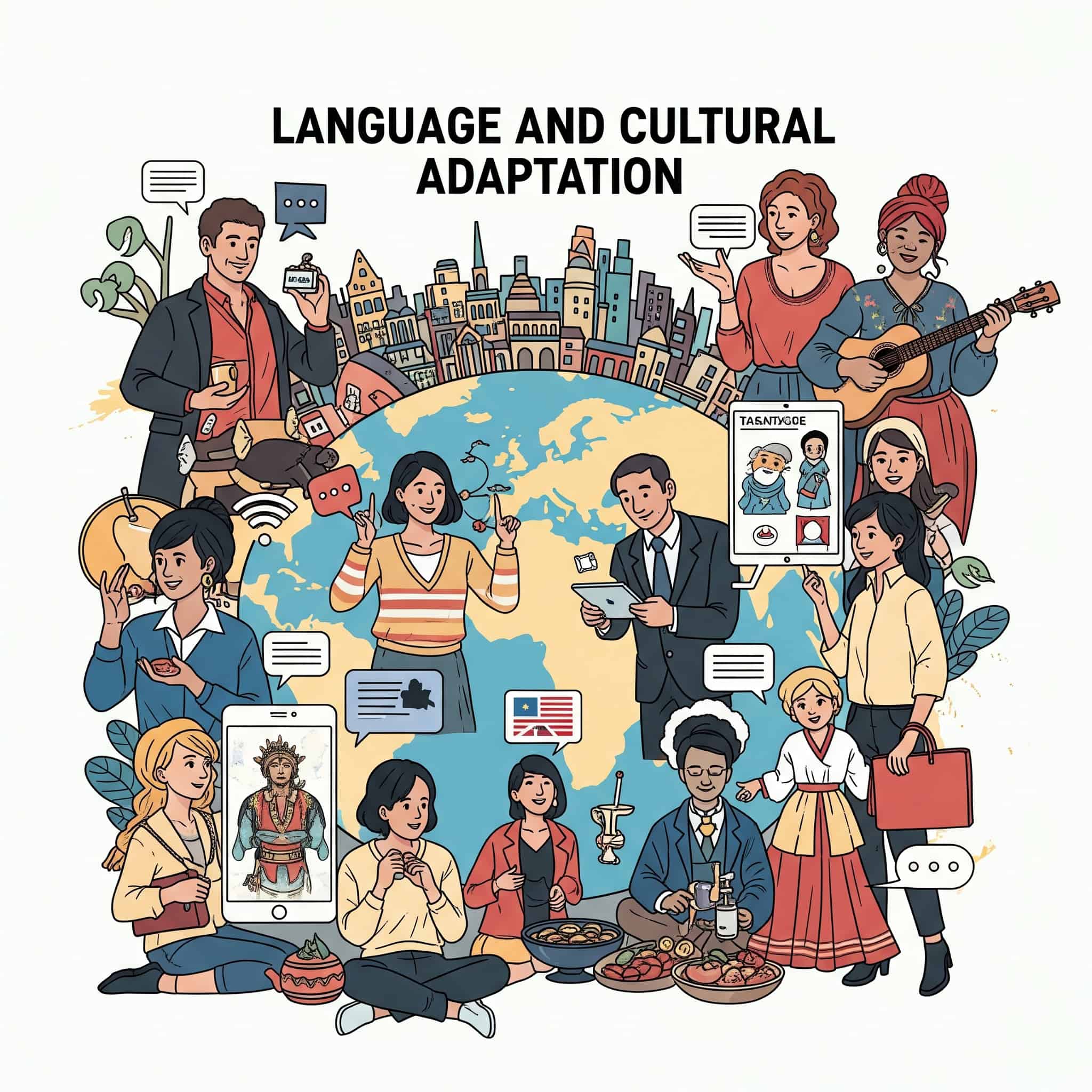Moving to Quebec from the US: 25 Essential Considerations for a Smooth Transition
Moving from the United States to Quebec represents a significant life change requiring careful planning. Recent statistics show approximately 10,000 Americans relocate to Canada annually, with Quebec attracting those seeking cultural richness and quality of life. I’ve compiled the most crucial considerations to help you navigate this international move with confidence and clarity.

Table of Contents
Immigration and Legal Requirements
Language and Cultural Adaptation
Practical Living Considerations
Financial Planning
Employment and Professional Considerations
How Jiffy Junk Can Help With Your Move
Final Thoughts
Immigration and Legal Requirements
Quebec maintains its own immigration system separate from the rest of Canada, requiring specific documentation and processes. Understanding these requirements early will save you significant time and frustration during your relocation journey. The province evaluates candidates based on factors including French language ability, education, work experience, and adaptability.
Quebec’s immigration programs operate on a points-based system with different thresholds for different programs. If you’re applying as a single applicant to the Quebec Skilled Worker Program, you’ll typically need to score at least 50 points to be considered.
Document preparation is no small task. You’ll need certified French translations of all your English documents, and these must be done by Quebec-approved translators. For your educational qualifications, credential assessment services like WES are necessary to verify your degrees are equivalent to Canadian standards.
Quebec Immigration Program | Key Eligibility Requirements | Processing Time | Best For |
|---|---|---|---|
Quebec Skilled Worker (QSWP) | 50+ points, French proficiency | 12-18 months | Professionals with in-demand skills |
Quebec Experience Program (PEQ) | Quebec education or work experience | 6-12 months | Students/workers already in Quebec |
Quebec Investor Program | Net worth CAD $2M, investment of CAD $1.2M | 24-36 months | High net worth individuals |
Quebec Entrepreneur Program | Net worth CAD $300K, business experience | 18-24 months | Experienced business owners |
1. Quebec-Specific Immigration Pathways
Quebec operates its own immigration programs distinct from federal Canadian options. The main pathways include the Quebec Skilled Worker Program (QSWP), Quebec Experience Program (PEQ), and Quebec Investor Program. Each has specific eligibility requirements and processing procedures tailored to Quebec’s unique needs.
The QSWP evaluates candidates through a points system that heavily weights French language ability, education, work experience, and age. If you’re strong in these areas, this could be your best route.
The PEQ targets individuals already living in Quebec with work experience or Quebec educational credentials. One major advantage? It requires less processing time than other programs, often getting you permanent residency faster if you qualify.
2. Work Permit Requirements
Temporary work permits often serve as stepping stones to permanent residency. For US citizens, the Canada-United States-Mexico Agreement (CUSMA, formerly NAFTA) provides facilitated work permit options for certain professions. Understanding permit duration, renewal processes, and pathways to permanent status is crucial.
CUSMA work permits for eligible professionals like engineers, scientists, and management consultants typically process in 4-6 weeks. These permits are valid for up to 3 years, giving you a solid foothold in Quebec.
It’s important to understand that work permits don’t automatically lead to permanent residency. You’ll need to apply through appropriate immigration programs while maintaining legal status. This requires careful planning and timing to ensure you don’t inadvertently lose your legal right to remain in Canada.
Sarah, a software engineer from Boston, utilized the CUSMA work permit pathway to move to Montreal. She secured a job offer from a Quebec tech company, applied for her work permit at the border with her employment letter, degree, and resume, and received approval the same day. After working for two years, she applied for permanent residency through the Quebec Experience Program, leveraging her established Quebec work history and intermediate French skills acquired through evening classes.
3. Essential Documentation Preparation
Relocating to Quebec requires gathering numerous personal documents including birth certificates, marriage certificates, educational credentials, and employment records. All English documents must be professionally translated into French by certified translators recognized by the Quebec government.
Document gathering typically takes 3-6 months for most applicants. Don’t underestimate this timeline! You’ll need additional time for translation and authentication, which can add weeks or even months to your preparation.
Educational credentials require evaluation through services like World Education Services (WES) before they can be recognized in Quebec. This process involves sending original documents, paying fees, and waiting for assessment results, which can take several weeks.
Before moving to Quebec, you’ll need to sort through years of accumulated belongings. Check out our guide on how to get rid of clutter for effective strategies to streamline your possessions before the big move.
4. Quebec Selection Certificate Process
The Quebec Selection Certificate (CSQ) represents provincial nomination and is required before applying for permanent residency at the federal level. The application is submitted through Quebec’s Arrima portal, with processing times varying based on program and current volumes.
CSQ processing typically takes 6-12 months after submission through the Arrima portal. This is a significant waiting period that needs to be factored into your overall immigration timeline.
Once issued, the certificate remains valid for 24 months. During this time, you must complete your federal permanent residency application. Missing this window means starting the provincial nomination process all over again.
5. Residency Timeline Planning
Understanding the transition from temporary to permanent status helps set realistic expectations for your move. Permanent residency requires maintaining physical presence in Canada, while citizenship eligibility begins after three years of permanent resident status.
Permanent residency comes with specific obligations. You must be physically present in Canada for at least 730 days within a five-year period to maintain your status. This requirement limits how much time you can spend outside Canada, including visits back to the US.
Citizenship eligibility begins after 3 years of permanent residency. The process includes passing a test covering Canadian history, government, and values. Many Americans choose to pursue dual citizenship once eligible, allowing them to maintain connections to both countries.
Language and Cultural Adaptation
Quebec’s predominantly French-speaking environment presents both challenges and opportunities for Americans. Language proficiency impacts everything from immigration eligibility to daily interactions and employment prospects. Cultural differences extend beyond language to social norms, holidays, and traditions.
French language proficiency is evaluated through standardized tests like the Test d’évaluation de français (TEF). Most immigration programs require at least a B2 (upper intermediate) level, which represents a significant commitment for English speakers with no prior French knowledge.
Bill 96, which strengthened French language requirements in 2022, has affected access to government services, education, and business operations for non-French speakers. This legislation has real implications for daily life, making French language acquisition even more important for newcomers.
6. French Language Proficiency Requirements
Most Quebec immigration programs require demonstrated French language proficiency. The Test d’évaluation de français (TEF) is commonly used to assess language skills on a scale from A1 (beginner) to C2 (mastery). Your score directly impacts immigration eligibility and employment opportunities.
The TEF exam evaluates four competencies: listening, reading, writing, and speaking. Most immigration programs require minimum B2 level proficiency, which represents the ability to interact effectively with native speakers on a wide range of topics.
Test preparation typically requires 6-12 months of dedicated study for English speakers with no prior French knowledge. This is a significant time investment that should be started well before you plan to apply for immigration programs.
French Proficiency Level | QSWP Points | Description | Approximate Study Time |
|---|---|---|---|
A1 (Beginner) | 0-2 points | Basic phrases, simple interactions | 3-6 months |
A2 (Elementary) | 2-4 points | Simple conversations, basic needs | 6-12 months |
B1 (Intermediate) | 4-6 points | Clear expression on familiar topics | 12-18 months |
B2 (Upper Intermediate) | 6-8 points | Effective interaction with native speakers | 18-24 months |
C1 (Advanced) | 8-10 points | Fluent expression, complex topics | 24-36 months |
C2 (Mastery) | 10-12 points | Near-native proficiency | 36+ months |
7. Available Language Learning Resources
Quebec offers numerous resources to help newcomers learn French. The Ministry of Immigration provides free French courses through the Programme d’intégration linguistique pour les immigrants (PILI). Options include part-time, full-time, and online formats with financial assistance available for eligible immigrants.
Government-subsidized courses provide up to 1,800 hours of French instruction for eligible immigrants. This is a substantial benefit that can save you thousands of dollars in language education costs.
Language learning apps like Duolingo and Babbel offer supplementary practice, but immersion remains the most effective approach for functional fluency. I’ve found that combining formal instruction with daily practice in real-world settings accelerates progress significantly.
8. Impact of Bill 96 on Daily Life
Recent strengthening of French language laws through Bill 96 affects education, business operations, and government services for English speakers. Since June 2022, most government services are exclusively provided in French, with limited exceptions for “historic anglophones.”
New immigrants must conduct government business in French after six months of residency. This creates a practical deadline for achieving basic functional French skills, making immediate language learning a priority upon arrival.
Businesses with 25+ employees must operate primarily in French, affecting workplace language policies and documentation. This has implications for job seekers, as employers increasingly require French proficiency even in positions that previously operated in English.
9. Cultural Integration Strategies
Quebec’s unique cultural identity blends North American and European influences. Understanding local holidays like St-Jean-Baptiste Day, social customs, and historical context facilitates integration. Organizations like Immigrant Quebec offer cultural orientation workshops specifically designed for newcomers.
Quebec’s distinct cuisine, music traditions, and arts scene reflect its unique cultural position between North America and Europe. Embracing these cultural elements helps build connections with locals and deepens your appreciation for your new home.
Social norms differ from American practices, with longer meal times, different greeting customs, and more emphasis on work-life balance. Being aware of these differences helps avoid misunderstandings and demonstrates respect for local culture.
Michael, a marketing professional from Chicago, initially struggled with Quebec’s cultural differences despite his basic French skills. He accelerated his integration by joining a local curling club, attending French conversation meetups at Café Second Cup every Thursday, and volunteering at the Montreal Jazz Festival. These activities provided regular language practice in relaxed settings while helping him build a social network. Within a year, he felt comfortable navigating daily life in French and had developed meaningful connections with Quebec natives who helped him understand local customs and expressions not taught in language classes.
10. Bilingual Areas and Communities
Certain regions and neighborhoods have higher concentrations of English speakers, potentially easing your transition. West Island neighborhoods in Montreal (like Westmount and Beaconsfield) and Chelsea in the Gatineau region offer more bilingual services and English-speaking communities.
Living in bilingual areas can facilitate initial adjustment but may slow French language acquisition and full cultural integration. I’ve seen many newcomers get comfortable in these English bubbles and struggle to integrate more fully into Quebec society as a result.
Housing in these areas typically commands premium prices due to their popularity with anglophone residents. Expect to pay 10-20% more for comparable properties in these neighborhoods compared to predominantly francophone areas.
Practical Living Considerations
Day-to-day life in Quebec involves navigating systems that differ significantly from their US counterparts. From healthcare enrollment to housing searches, understanding these practical considerations helps establish your new life efficiently. Planning for these differences prevents unnecessary stress during your transition.
Healthcare enrollment through the Régie de l’assurance maladie du Québec (RAMQ) involves a waiting period for new immigrants. This creates a coverage gap that requires temporary private insurance to avoid potentially catastrophic medical expenses.
Quebec’s July 1st “Moving Day” tradition creates unique rental market dynamics, with most leases turning over simultaneously. This means intense competition for apartments during May and June, but also more available inventory than at other times of the year.
When planning your move to Quebec, you’ll need to carefully consider what to bring along. Our comprehensive decluttering guide can help you decide what’s worth keeping and what should be left behind before your international relocation.
11. Healthcare System Navigation
Quebec’s public healthcare system provides comprehensive coverage through the Régie de l’assurance maladie du Québec (RAMQ). New permanent residents face a waiting period of up to 3 months before coverage begins, making temporary private health insurance essential during this gap.
Private health insurance during the waiting period costs approximately CAD $100-200 monthly per person. Providers like Manulife and Sun Life offer newcomer packages specifically designed for this transition period.
Once enrolled, RAMQ covers doctor visits and hospital care but not prescription medications, dental care, or vision services. This partial coverage differs from many US health insurance plans and requires additional planning for these excluded services.
12. Housing Search Strategies
Finding appropriate accommodations requires understanding Quebec’s unique rental market. Websites like Kijiji.ca and LesPAC.com list available properties, while July 1 serves as the traditional “Moving Day” when most leases turn over. This creates higher competition but more inventory during May-June.
Rental agreements in Quebec strongly favor tenant rights, with restrictions on security deposits and rent increases. Landlords cannot require security deposits, though they may ask for the first month’s rent in advance. This tenant-friendly approach differs significantly from many US rental markets.
Lease terms typically run for 12 months with automatic renewal unless notice is provided. This requires careful planning for move-out timing, as failing to provide proper notice can result in automatic renewal for another year.
13. Banking and Financial Services Setup
Establishing your financial presence in Quebec involves opening Canadian bank accounts, building credit history, and transferring assets from US financial institutions. Major Canadian banks offer newcomer packages with fee waivers and credit-building options specifically designed for immigrants.
The Nexus program helps transfer credit history from the US to Canada, potentially accelerating credit establishment. Without this program, you’ll essentially be starting from scratch with Canadian credit, making it difficult to qualify for loans or credit cards initially.
Canadian banking differs from US systems with Interac e-transfers replacing checks and different fee structures for services. Monthly account fees are more common in Canada, though newcomer packages often waive these fees for the first year.
14. Education System Differences
Quebec’s education system includes unique elements like CEGEP (a pre-university college system) after high school. Children of temporary residents may need to attend private schools, while permanent residents can access public education with French instruction (with exceptions for eligible English education).
Quebec’s public education system operates primarily in French. English instruction is limited to children of parents who received their primary education in English in Canada. This “historic anglophone” rule means most newcomers’ children will attend French schools unless enrolled in private institutions.
International and private schools offer English-language education options but at significant cost (CAD $15,000-25,000 annually). This expense needs to be factored into your budget if English education is a priority for your family.
15. Transportation and Driving Requirements
Quebec will exchange a valid US driver’s license without testing, but this must be completed within 6 months of arrival. The province uses the metric system for speeds and distances, and winter tires are legally required from December 1 to March 15 due to severe winter conditions.
Driver’s license exchange requires proof of driving experience, identity verification, and vision testing at a cost of approximately CAD $90. Missing the 6-month window means taking the full Quebec driving exam, including both written and road tests.
Winter driving necessitates additional skills and equipment. Winter tire installation costs CAD $60-100 per season, but it’s not optional – it’s legally required and essential for safety on Quebec’s snow-covered roads.
Financial Planning
Financial preparation for your move involves understanding cost differences, tax implications, and strategies for managing assets across borders. Quebec generally offers lower housing costs than major US cities but has higher taxes and different expense patterns that affect overall affordability.
Combined federal and provincial income tax rates in Quebec reach 53.31% for income over CAD $216,511. This is significantly higher than most US tax jurisdictions, creating a substantial difference in take-home pay for high earners.
US citizens maintain tax filing obligations regardless of residence. This creates complex dual-country tax situations requiring specialized accounting assistance. The cost of this expertise is an ongoing expense that needs to be factored into your budget.
Expense Category | Quebec Average | US Comparison | Key Differences |
|---|---|---|---|
Housing (2BR Apt) | CAD $1,200-1,800 | 10-30% higher in major US cities | Lower purchase prices but higher property taxes |
Groceries | CAD $400-600/month | 10-15% higher in Quebec | More seasonal price fluctuations |
Healthcare | Covered by RAMQ | Significantly lower than US insurance | 3-month waiting period for new residents |
Childcare | CAD $8.70-22/day | 50-70% lower than US averages | Subsidized provincial system with waiting lists |
Transportation | CAD $90/month (transit) | Public transit more comprehensive | Car insurance 15-25% lower than US averages |
Utilities | CAD $150-300/month | Electricity cheaper, heating more expensive | Seasonal variation due to winter heating costs |
Taxes | Up to 53.31% combined rate | Significantly higher than most US states | Additional social benefits offset higher rates |
16. Cost of Living Comparisons
Quebec’s cost structure differs significantly from most US locations. A family of four in Montreal typically spends around CAD $4,500-5,500 monthly excluding housing. Rent for a 2-bedroom apartment averages CAD $1,200-1,800 in Montreal and CAD $900-1,400 in Quebec City, generally lower than major US metropolitan areas.
Grocery costs run approximately 10-15% higher than US averages. This difference is particularly noticeable for fresh produce during winter months, when prices can spike significantly due to import costs.
Utility costs vary seasonally with higher heating expenses during winter months (CAD $150-300 monthly) offset by lower electricity rates overall. Quebec’s hydroelectric power provides some of North America’s lowest electricity rates, but heating a home through the harsh winter can be costly.
Many Americans moving to Quebec are surprised by the similarities with our article on moving to Canada from the US, which covers important emotional and practical aspects that apply equally to Quebec’s unique provincial situation.
17. Cross-Border Tax Planning
Quebec has the highest provincial income tax rates in Canada, with combined federal and provincial rates reaching 53.31% for high earners. US citizens must continue filing US tax returns regardless of residence but can avoid double taxation through the Foreign Earned Income Exclusion and tax treaties between the countries.
Professional cross-border tax preparation typically costs CAD $500-1,500 annually depending on complexity. This is an ongoing expense that should be factored into your budget, as self-filing becomes increasingly difficult with cross-border considerations.
The US-Canada Tax Treaty provides mechanisms to prevent double taxation but requires careful planning and documentation. Working with a tax professional familiar with both systems is essential to optimize your tax situation and avoid costly mistakes.
Jennifer, a management consultant earning CAD $120,000 annually in Montreal, initially struggled with her complex tax situation as a US citizen living in Quebec. She hired a cross-border tax specialist who helped her implement a comprehensive strategy: filing her US returns using the Foreign Earned Income Exclusion (saving approximately $15,000 in US taxes), utilizing the US-Canada Tax Treaty’s provisions to avoid double taxation on her investments, and timing her RRSP (Canadian retirement account) contributions to maximize tax benefits in Canada. The specialist also advised her to maintain a US credit card to preserve her US credit history while building her Canadian credit profile.
18. Retirement Account Management
Moving to Quebec necessitates strategic management of US retirement accounts. IRAs can be maintained but not contributed to while living in Canada. 401(k)s can be rolled over to IRAs before moving or withdrawn (with tax implications). Canadian RRSPs offer similar tax advantages for Canadian residents.
Withdrawals from US retirement accounts while residing in Canada trigger both US and Canadian tax considerations. This can affect tax efficiency, as the timing and amount of withdrawals need to be carefully planned to minimize overall tax burden.
Canadian RRSPs (Registered Retirement Savings Plans) provide tax-deferred growth similar to US IRAs but with different contribution limits and withdrawal rules. As a Quebec resident, you can begin building Canadian retirement savings while maintaining your existing US accounts.
19. Healthcare Financial Planning
While Quebec’s basic healthcare is covered through RAMQ, additional expenses require planning. Prescription medications average CAD $1,000 annually per person, while dental and vision services remain out-of-pocket expenses. Employer health plans or private insurance can cover these additional costs.
Supplemental health insurance costs approximately CAD $150-300 monthly for family coverage. This expense is worth considering, especially if you have ongoing prescription needs or anticipate dental work.
Quebec’s public drug insurance plan (RAMQ Prescription Drug Insurance) provides basic coverage for those without private plans at income-based premium rates. This mandatory program ensures all residents have at least minimal prescription coverage, though with higher deductibles and co-pays than many private plans.
20. Currency Exchange Management
Developing a strategy for converting USD to CAD minimizes exchange costs and optimizes purchasing power. Services like Wise (formerly TransferWise) or OFX typically offer better exchange rates than traditional banks. Setting up USD accounts at Canadian banks allows timing conversions based on favorable rates.
Exchange rate fluctuations can significantly impact purchasing power. Historical USD-CAD variations of 5-15% annually mean that timing your currency conversions can result in substantial savings.
Wire transfer fees from US to Canadian banks typically range from $25-50 per transaction. This makes larger, less frequent transfers more cost-effective than multiple smaller transfers. I’ve found that quarterly transfers often provide the best balance between fee minimization and cash flow management.
Employment and Professional Considerations
Your professional transition to Quebec involves understanding licensing requirements, job market conditions, and networking strategies. Many professions require Quebec-specific certification or credential recognition, potentially creating career interruptions during the relocation process.
Professional licensing processes typically take 6-18 months depending on the field. Healthcare and legal professions face the most rigorous requirements, often requiring additional education or supervised practice periods.
Quebec’s job market features lower unemployment rates than US averages but also generally lower salaries when calculated in USD. This salary differential varies by industry but typically ranges from 10-30% lower than comparable US positions.
21. Professional Licensing and Recertification
Many professions require Quebec-specific licensing or credential recognition. Engineers must register with the Ordre des ingénieurs du Québec, requiring credential evaluation, French proficiency, and possibly additional exams. Healthcare professionals face particularly rigorous licensing processes through professional colleges.
Licensing costs vary by profession, typically ranging from CAD $500-2,500 for application and examination fees. These costs should be factored into your relocation budget, along with potential income loss during the licensing period.
Some professions require returning to school for supplementary courses or completing supervised practice periods before full licensure. This can extend the time before you can practice your profession in Quebec, potentially creating a significant gap in employment.
22. Job Market Research Strategies
Understanding employment opportunities in your field helps determine relocation viability. Montreal’s technology sector is growing rapidly, with artificial intelligence and video game development as particular strengths. Quebec City offers opportunities in insurance, government, and manufacturing sectors with different salary structures and growth potential.
Industry-specific salary differences between US and Quebec markets range from 10-30% lower in Quebec when converted to USD. This variation depends on the field, with technology and finance showing smaller gaps than retail or service industries.
Job search platforms like Indeed.ca, Jobboom.com, and Emploi-Québec list Quebec-specific opportunities with different formats than US job boards. I’ve found that these local platforms often list positions that never appear on international job sites, making them essential resources for your job search.
23. Professional Networking Approaches
Building professional connections is essential in Quebec’s relationship-oriented business culture. Industry-specific groups like Montreal International and Quebec International offer newcomer networking events. LinkedIn groups such as “Professionals in Quebec” and “Montreal Professionals Network” facilitate digital connections.
Professional associations often offer reduced membership rates for newcomers and provide valuable networking opportunities. These organizations frequently host events specifically designed to help new arrivals connect with established professionals in their field.
Quebec business culture emphasizes relationship-building before business transactions. This requires more time investment in networking than typical US practices, where transactions often proceed more quickly. Be prepared to spend time developing professional relationships before seeing concrete business results.
If you’re planning to work remotely for a US employer while living in Quebec, you’ll need a proper home office setup. Our guide on how to clean out an office provides valuable insights for creating an efficient workspace in your new Quebec home.
24. Entrepreneurship and Business Ownership
Quebec offers specific immigration pathways for entrepreneurs. The Self-Employed Worker Program requires a net worth of CAD $100,000 and experience running a business. Quebec also provides startup visas for innovative business concepts with support from designated organizations and incubators.
Business registration in Quebec requires French documentation and compliance with French language laws for customer service and marketing. All business signage, websites, and customer communications must be available in French, with potential fines for non-compliance.
Tax incentives for new businesses include R&D credits and sector-specific programs, particularly in technology and cultural industries. These incentives can significantly reduce the tax burden for qualifying businesses, making Quebec an attractive location for certain types of startups.
25. Remote Work Considerations
Working remotely for a US employer while living in Quebec creates complex tax and legal situations. The arrangement may create “permanent establishment” concerns for employers. Solutions include working through an Employer of Record (EOR) service or having the employer establish a Canadian subsidiary.
Remote work arrangements require careful structuring to avoid creating tax liabilities for US employers in Canada. Without proper planning, your US employer could inadvertently establish a Canadian tax presence, creating significant compliance issues.
Income earned while physically present in Quebec becomes subject to Quebec taxation regardless of employer location. This means you’ll need to pay Quebec’s higher tax rates on your US income, potentially reducing your effective take-home pay compared to living in the US.
How Jiffy Junk Can Help With Your Move
International relocation forces tough decisions about possessions. Jiffy Junk offers comprehensive removal services that handle unwanted items before your Quebec journey begins. Their team prioritizes donations and recycling, reflecting Quebec’s environmental consciousness while saving you shipping costs and logistical headaches.
Professional junk removal eliminates the stress of disposing large items. Jiffy Junk handles everything from furniture to electronics and household goods, providing a turnkey solution for clearing out your US residence before your international move.
Their eco-friendly disposal methods ensure up to 60% of removed items avoid landfills through donation networks and recycling facilities. This aligns well with Quebec’s strong environmental values and gives you peace of mind that your discarded possessions are being handled responsibly.
Before relocating to Quebec, you’ll need to decide what to do with furniture that won’t make the journey. Our furniture removal guide provides essential tips for responsibly disposing of items you can’t bring along, helping reduce your moving costs and environmental impact.
David and Lisa, a couple relocating from Seattle to Montreal, faced overwhelming logistics when downsizing their 3-bedroom house before the move. They contacted Jiffy Junk three weeks before their departure date for a comprehensive cleanout. The service removed their bulky furniture, outdated appliances, and accumulated basement items in a single day. This eliminated approximately 40% of their possessions, reducing their international shipping quote by over $2,800. Additionally, Jiffy Junk documented all donated items, providing receipts that David and Lisa used for tax deductions totaling nearly $1,200 on their final US tax return.
Final Thoughts
Relocating to Quebec represents a multifaceted transition requiring careful planning across immigration, language, practical living, financial, and professional domains. Your success hinges on thorough preparation and realistic expectations. The cultural richness and quality of life awaiting in Quebec reward those who approach the move with patience and adaptability.
Creating a month-by-month preparation timeline helps manage the complex moving process without overwhelming yourself. I recommend starting at least 12-18 months before your intended move date to allow sufficient time for language learning, document preparation, and professional transitions.
Maintaining connections with both your new Quebec community and your US support network eases the emotional aspects of international relocation. Regular video calls, planned visits, and introducing friends and family to your new home can help bridge the distance and make your transition smoother.
For those considering the broader implications of relocating internationally, our article on moving to France from the US offers complementary insights that may be particularly relevant given Quebec’s French cultural connections and similar adjustment challenges.








